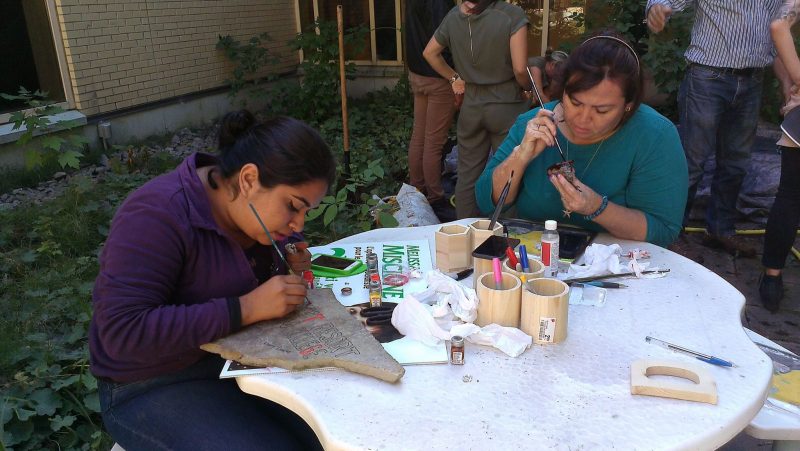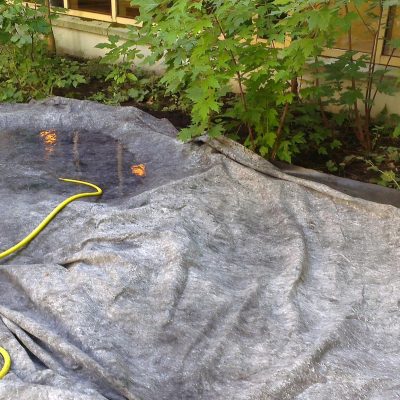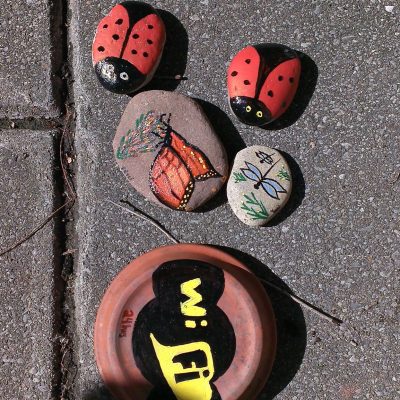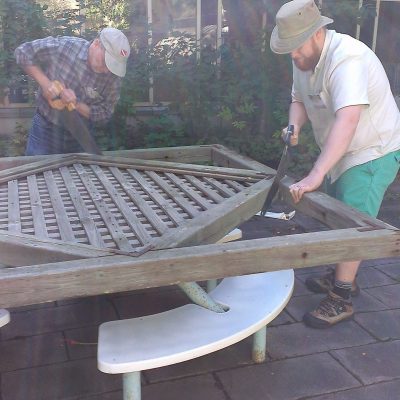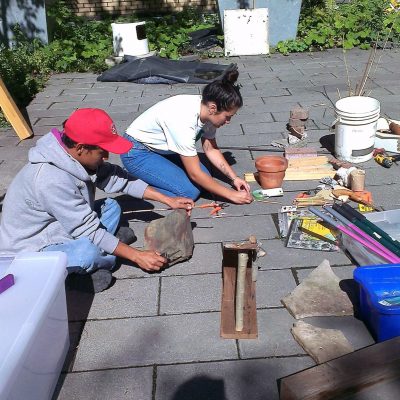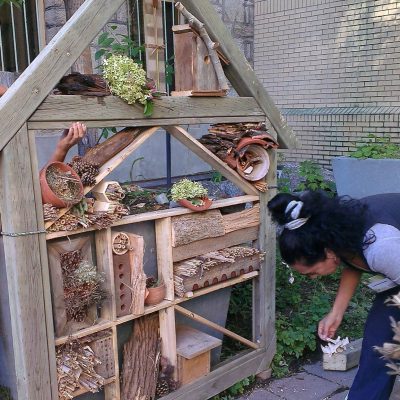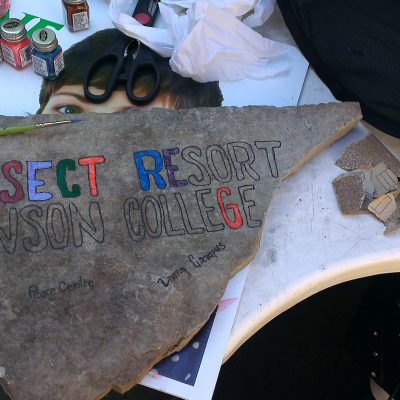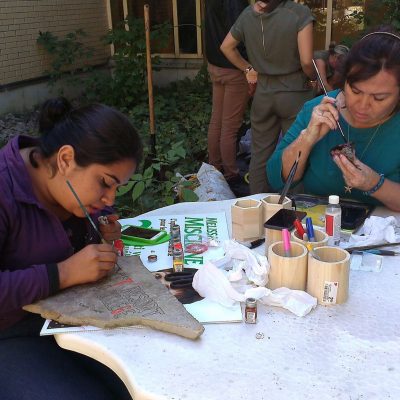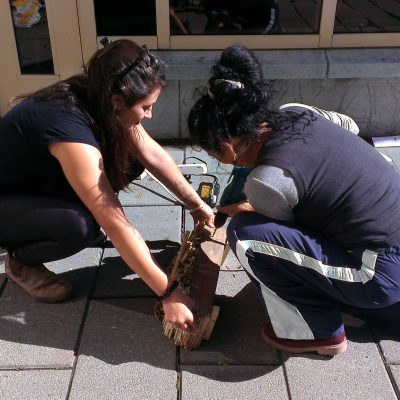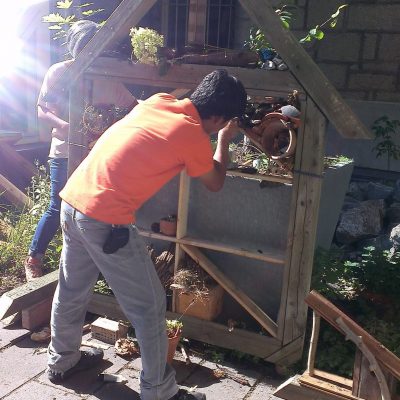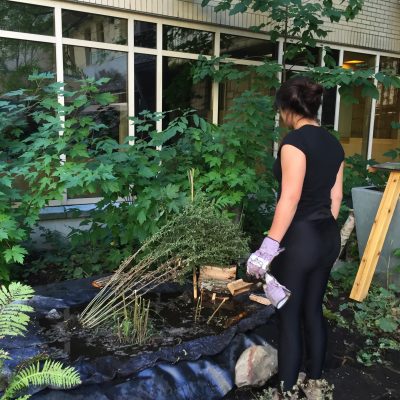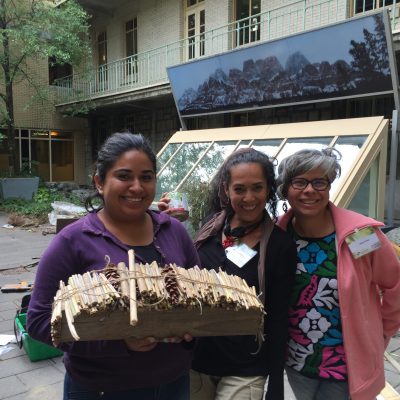English Translation follows
Por Luisa Montes
15 de septiembre de 2016, segundo día de actividades del simposio por la paz, después de un saludo cordial a los compañeros de los otros proyectos del Peace Centre (Galería de Arte indígena y Herramientas para la paz), volvimos a la tarea. La restauración urbana había comenzado sobre el techo del gimnasio en el College. Al extremo derecho de la puerta de acceso estaban los trabajos del Resort para Insectos y en el extremo izquierdo comenzaba a dibujarse el estanque del techo. En el centro se encontraban las herramientas, insumos y un grupo de personas realizando propuestas artísticas.
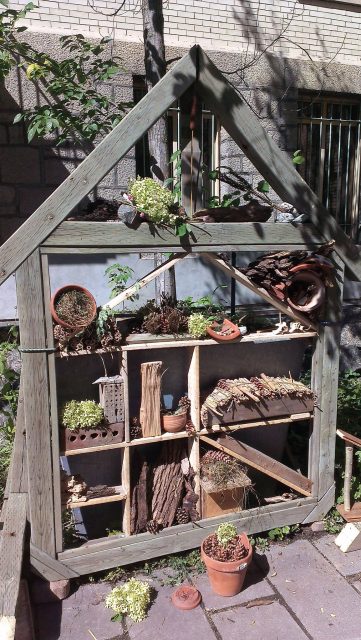 Digamos que a primera vista, éramos un grupo de personas trabajando en un proyecto común, cada cual con lo que sabía aportar, cada uno con la libertad de ser parte de cada aspecto del proyecto, por lo tanto, era posible encontrar una cámara fotográfica junto a un par de piedras decoradas como catarinas y un serrucho con rastros de aserrín en los dientes, si alguno requería ayuda no dudaba en pedirla a quien estuviese a un lado, era seguro que obtendríamos el apoyo preciso, así que en realidad, éramos un grupo de la especie humana haciendo comunidad mientras trabajábamos en pro de que otros grupos de otras especies tuvieran lo necesario para construir comunidad. ¡Genial!
Digamos que a primera vista, éramos un grupo de personas trabajando en un proyecto común, cada cual con lo que sabía aportar, cada uno con la libertad de ser parte de cada aspecto del proyecto, por lo tanto, era posible encontrar una cámara fotográfica junto a un par de piedras decoradas como catarinas y un serrucho con rastros de aserrín en los dientes, si alguno requería ayuda no dudaba en pedirla a quien estuviese a un lado, era seguro que obtendríamos el apoyo preciso, así que en realidad, éramos un grupo de la especie humana haciendo comunidad mientras trabajábamos en pro de que otros grupos de otras especies tuvieran lo necesario para construir comunidad. ¡Genial!
Así, poco a poco el estanque y el hotel de insectos fueron tomando forma, los que sabían de clima, de especies y comportamientos indicaban el mejor lugar para realizar los hábitats, los que sabían de construcción indicaban los detalles a considerar para realizar el proyecto sin afectar ninguna estructura, los que sabían cantar, preparaban canciones y amenizaban el trabajo, quienes sabían dibujar, escribir, buscar información de manera cuasi inmediata, eso hacían… una orquesta haciendo una Oda a la colaboración, eso evoca mi recuerdo.
Para la tarde noche, un deleite escuchar al filósofo francés Abdennour Bidar, nos contó que a los seis años de edad se dio cuenta de que el mundo estaba roto, encontró conexiones desgastadas, rasgadas o rotas entre los seres humanos mientras trataban de hacer las cosas bien… -yo quiero reconectar esos hilos rotos- dijo aquel niño, sus padres creyeron en que lo haría, le dieron su apoyo y se volvió un filósofo, nos habló de su trabajo más reciente “Tejedores”, es verdad que hemos oído hablar antes de la reconstrucción del tejido social, pero Bidar propone un tejido mucho más profundo, debemos reconectarnos en tres niveles para intentar ahora que todavía estamos a tiempo, que el mundo roto se reconecte, el primero es reconectarnos a nivel social, es decir, con los otros, el segundo nivel de reconexión es con la naturaleza, nuestra casa común, y el tercer nivel, con el universo, con el espíritu universal, yo agrego el nivel cero, el que origina los demás, la reconexión con nosotros mismos, cuanto aprendizaje en una hora y treinta minutos.
La jornada terminó tarde, había que descansar un poco y prepararnos para vivir el tercer día de actividades.
Symposium for Peace / Urban Restoration / Day 2
By Luisa Montes
Translated by Gisela Frias
September 15, 2016 was the second day of the Symposium for Peace at Dawson College. After a cordial gathering with other participants of the Projects for Peace (Indigenous Art Gallery and Tools for Peace), we returned to our task. The urban restoration project had begun on the roof of the College’s gymnasium. To the extreme right of the entrance door was the “Insect Resort” and on the far left we began to see what would eventually be a pond on the roof. At the center of the room you could see the tools, materials and a group of people carrying out different artistic proposals.
 Let’s say that at first glance, we were a group of people working on a common project. Each of us came with what one could contribute, each with the freedom to become involved in every aspect of the project. You could find a camera right next to a couple of stones decorated as ladybugs and there were traces of sawdust on the saw. Anyone who needed help with his or her task did not hesitate to ask and was sure to find the necessary support. So, actually, we were a group individuals from the human specie building a community while we worked to support other groups of other species so that they would have what they needed to construct their community. It was great!
Let’s say that at first glance, we were a group of people working on a common project. Each of us came with what one could contribute, each with the freedom to become involved in every aspect of the project. You could find a camera right next to a couple of stones decorated as ladybugs and there were traces of sawdust on the saw. Anyone who needed help with his or her task did not hesitate to ask and was sure to find the necessary support. So, actually, we were a group individuals from the human specie building a community while we worked to support other groups of other species so that they would have what they needed to construct their community. It was great!
Gradually the pond and the Insect Hotel were taking shape. Those who knew about climate, species and their behavior would indicate to the rest what were the best places to work on the new habitats. Those who knew construction indicated the details to consider so that the projects would not impact the infrastructure. Those who knew how to sing enlivened the work atmosphere. Those who knew how to draw, write, research for information, did that…. it was an orchestra doing an ode to collaboration, and that is what I remember.
Towards the evening it was a delight to listen to the French philosopher Abdennour Bidar, who told us that at six years of age he realized that the world was broken, with profund torn or broken connections between human beings as they tried to do things well … “I want to reconnect those torn threads” he told himself as a boy. His parents believed he could. They gave him their support and he became a philosopher. He told us about his latest work “The Weavers”. It is true that we have heard before about the reconstruction of the social fabric. But, Bidar proposes a much deeper tissue. We must reconnect on three levels and we need to do so now that we are still in time. broken world reconnects as we first reconnect socially, ie with others, secondly we reconnec with nature, our common home, and the thirdly, with the universe, with the universal spirit. I add one more level of connection, which brings about the others, that we reconnect with ourselves. So much to learn in one hour and thirty minutes.
The day ended late, we had to rest a bit and prepare to live the third day of activities.

